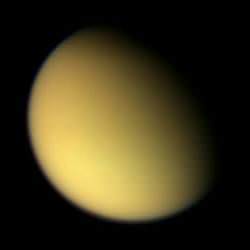
Natural color view of Titan. Image credit: NASA/JPL/SSI Click to enlarge
As Cassini approached Titan on Aug. 21, 2005, it captured this natural color view of the moon’s orange, global smog. Titan’s hazy atmosphere was frustrating to NASA Voyager scientists during the first tantalizing Titan flybys 25 years ago, but now Titan’s surface is being revealed by Cassini with startling clarity (see Titan Mosaic — East of Xanadu ).
Images taken with the wide-angle camera using red, green and blue spectral filters were combined to create this color view. The images were acquired at a distance of approximately 213,000 kilometers (132,000 miles) from Titan and at a Sun-Titan-spacecraft, or phase, angle of 55 degrees. Resolution in the image is about 13 kilometers (8 miles) per pixel.
The Cassini-Huygens mission is a cooperative project of NASA, the European Space Agency and the Italian Space Agency. The Jet Propulsion Laboratory, a division of the California Institute of Technology in Pasadena, manages the mission for NASA’s Science Mission Directorate, Washington, D.C. The Cassini orbiter and its two onboard cameras were designed, developed and assembled at JPL. The imaging operations center is based at the Space Science Institute in Boulder, Colo.
For more information about the Cassini-Huygens mission visit http://saturn.jpl.nasa.gov . The Cassini imaging team homepage is at http://ciclops.org .
Original Source: NASA/JPL/SSI News Release
